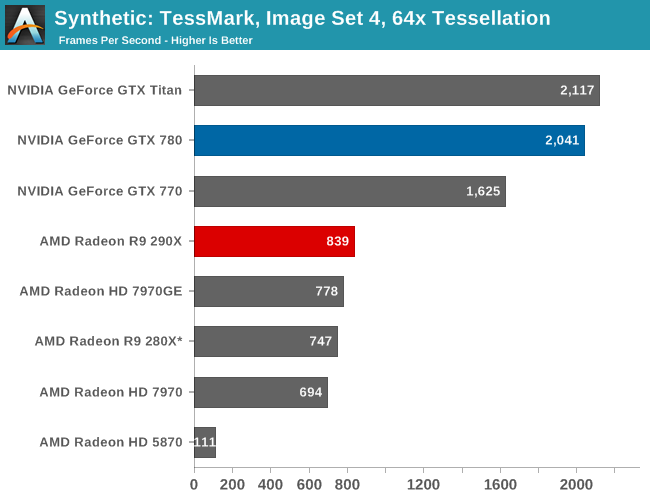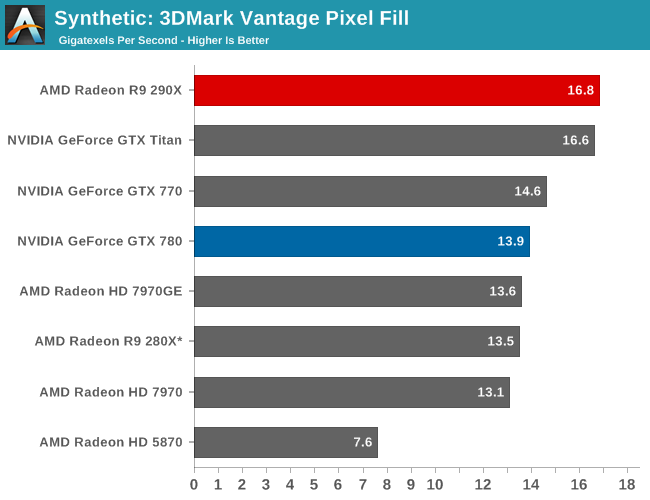The AMD Radeon R9 290X Review
by Ryan Smith on October 24, 2013 12:01 AM EST- Posted in
- GPUs
- AMD
- Radeon
- Hawaii
- Radeon 200
Synthetics
As always we’ll also take a quick look at synthetic performance. The 290X shouldn’t pack any great surprises here since it’s still GCN, and as such bound to the same general rules for efficiency, but we do have the additional geometry processors and additional ROPs to occupy our attention.

Right off the bat then, the TessMark results are something of a head scratcher. Whereas NVIDIA’s performance here has consistently scaled well with the number of SMXes, AMD’s seeing minimal scaling from those additional geometry processors on Hawaii/290X. Clearly Tessmark is striking another bottleneck on 290X beyond simple geometry throughput, though it’s not absolutely clear what that bottleneck is.
This is a tessellation-heavy benchmark as opposed to a simple massive geometry bencehmark, so we may be seeing a tessellation bottleneck rather than a geometry bottleneck, as tessellation requires its own set of heavy lifting to generate the necessary control points. The 12% performance gain is much closer to the 11% memory bandwidth gain than anything else, so it may be that the 280X and 290X are having to go off-chip to store tessellation data (we are after all using a rather extreme factor), in which case it’s a memory bandwidth bottleneck. Real world geometry performance will undoubtedly be better than this – thankfully for AMD this is the pathological tessellation case – but it does serve of a reminder of how much more tessellation performance NVIDIA is able to wring out of Kepler. Though the nearly 8x increase in tessellation performance since 5870 shows that AMD has at least gone a long way in 4 years, and considering the performance in our tessellation enabled games AMD doesn’t seem to be hurting for tessellation performance in the real world right now.
Moving on, we have our 3DMark Vantage texture and pixel fillrate tests, which present our cards with massive amounts of texturing and color blending work. These aren’t results we suggest comparing across different vendors, but they’re good for tracking improvements and changes within a single product family.

Looking first at texturing performance, we can see that texturing performance is essentially scaling 1:1 with what the theoretical numbers say it should. 36% better texturing performance over 280X is exactly in line with the increased number of texture units versus 280X, at the very least proving that 290X isn’t having any trouble feeding the increased number of texture units in this scenario.

Meanwhile for our pixel fill rates the results are a bit more in the middle, reflecting the fact that this test is a mix of ROP bottlenecking and memory bandwidth bottlenecking. Remember, AMD doubled the ROPs versus 280X, but only gave it 11% more memory bandwidth. As a result the ROPs’ ability to perform is going to depend in part on how well color compression works and what can be recycled in the L2 cache, as anything else means a trip to the VRAM and running into those lesser memory bandwidth gains. Though the 290X does get something of a secondary benefit here, which is that unlike the 280X it doesn’t have to go through a memory crossbar and any inefficiencies/overhead it may add, since the number of ROPs and memory controllers is perfectly aligned on Hawaii.










396 Comments
View All Comments
itchyartist - Thursday, October 24, 2013 - link
Incredible performance and value from AMD!The fastest single chip video card in the world. Overall it is faster than the nvidia Titan and only $549! Almost half the price!
Truly great to see the best performance around at a cost that is not bending you over. Battlefield 4 with AMD Mantle just around the corner. These new 290X GPUs are going to be uncontested Kings of the Hill for the Battlefield 4 game. Free battlefield game with the 290X too.Must buy.
Incredible!
Berzerker7 - Thursday, October 24, 2013 - link
...really? The card is $600. You reek of AMD PR.Novulux - Thursday, October 24, 2013 - link
It says $549 in this very review?Berzerker7 - Thursday, October 24, 2013 - link
It does indeed. His article still smells like pre-written script.siliconwizard - Thursday, October 24, 2013 - link
Like all the reviews state GTX Titan is now irrelevant. 290X took the crown and saved the wallet.siliconwizard - Thursday, October 24, 2013 - link
Thinking that sphere toucher' s comment is accurate. Bit of salt here over amd taking over the high end slot and ridiculing the titan card. Only going to get worse once the Mantle enabled games are rleased. Nvidia is finished for battlefield 4. Crushed by amd, 290x and mantle.MousE007 - Thursday, October 24, 2013 - link
Mantle.....lol , nvidia Gsync just killed AMDninjaquick - Thursday, October 24, 2013 - link
lol? a G-Sync type solution is a good candidate for being integrated into a VESA standard, and make it part of the Display's Information that is exchanged though DP/HDMI/DVI, so all AMD would need to do is make sure their drivers are aware that they can send frames to the screen as soon as they are finished. The best part would be that, with the whole Mantle deal, AMD would probably expose this to the developer, allowing them to determine when frames are 'G-Sync'd' and when they are not.MousE007 - Thursday, October 24, 2013 - link
No, there is a "hand- shake" between GPU and the monitor or tv, will not be supported with any other brand.inighthawki - Thursday, October 24, 2013 - link
You do realize that it can still be put into the VESA standard, right? Then only GPUs supporting the standard can take advantage of it. Also ANYONE who believes that GSync OR Mantle is going to "kill the other" is just an idiot.